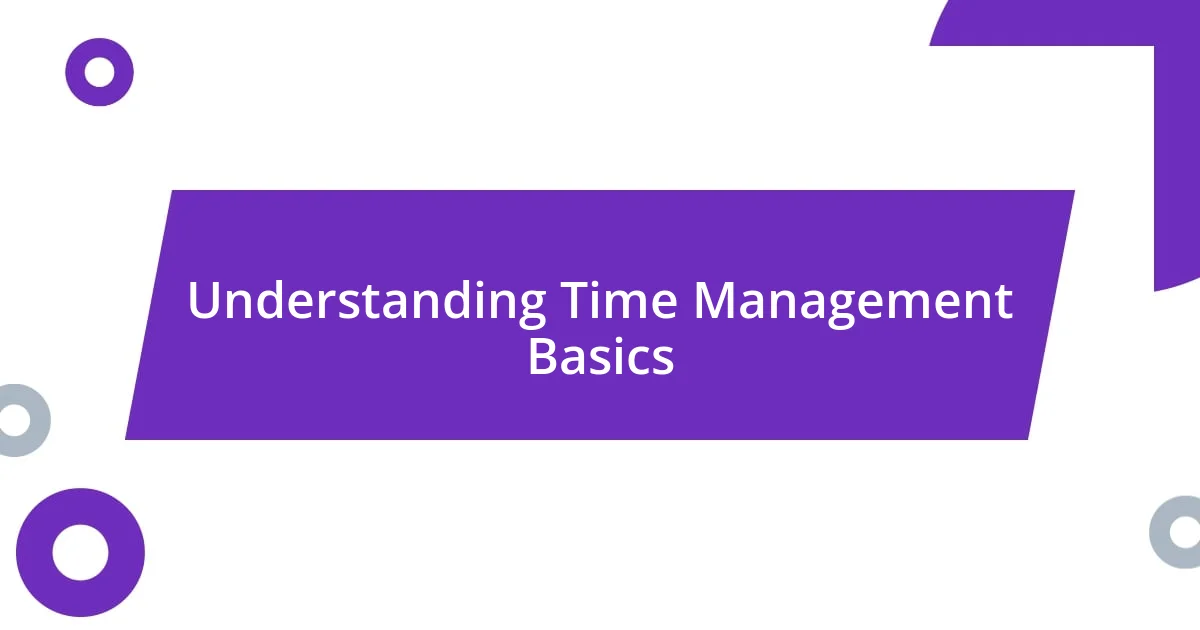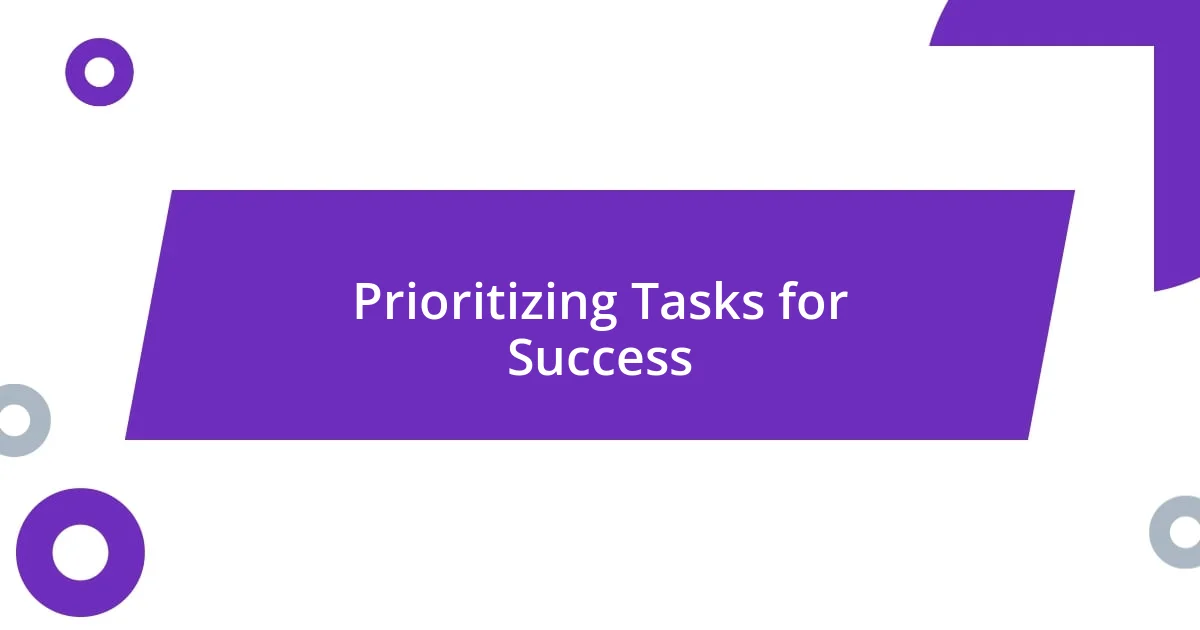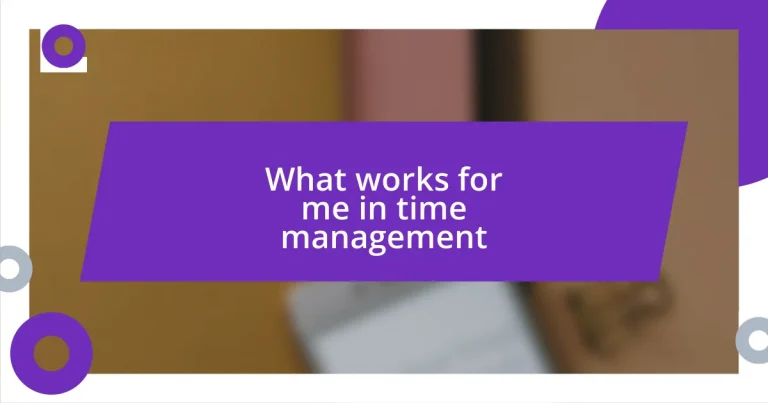Key takeaways:
- Establishing a routine and prioritizing tasks using tools like the Eisenhower Matrix significantly reduces stress and enhances productivity.
- Utilizing effective time management tools such as digital calendars, Todoist, and the Pomodoro Technique helps organize tasks and maintain focus.
- Reflecting on experiences, celebrating small achievements, and cultivating a positive mindset can transform one’s approach to time management and improve overall effectiveness.

Understanding Time Management Basics
When I first started exploring time management, I found that involving a routine could be a game changer. I remember setting aside just 10 minutes every night to plan my next day. This small commitment made me feel like I was taking control instead of being swept away by the chaos of my tasks.
Have you ever felt overwhelmed by your to-do list? I certainly have. In those moments, I realized that prioritizing tasks is vital. I began using the Eisenhower Matrix, which helped me distinguish between what’s urgent and important. It transformed how I view my daily activities, reducing my stress significantly.
Understanding time management basics requires self-awareness. I learned that my productivity peaks at specific times of the day; for instance, I tackle challenging tasks in the morning when my energy is highest. By aligning tasks with my natural rhythms, I discovered that time management isn’t just about tools and tips; it’s about understanding my own behavior and adapting accordingly.

My Personal Time Management Tools
When it comes to my personal time management tools, I can’t emphasize the importance of digital calendars enough. I use Google Calendar to block out time for both work tasks and personal commitments. Each Sunday, I sit down to map out the following week, and I genuinely feel a sense of calm wash over me when everything is laid out. This simple act allows me to visualize my commitments, manage my time better, and reduce that nagging dread of forgetting important deadlines.
I also rely on a few key apps and techniques that have become integral to my routine:
- Todoist: This keeps my tasks organized with due dates and priority levels.
- Pomodoro Technique: I work in 25-minute bursts, which sharpens my focus and allows for necessary breaks.
- Evernote: I jot down ideas, notes, or to-do lists wherever I am, ensuring nothing slips through the cracks.
Combining these tools with a bit of discipline has genuinely transformed how I navigate my days.

Prioritizing Tasks for Success
When I set out to prioritize my tasks, I learned that clarity is crucial. For instance, I once jumbled an important client meeting with my daughter’s school event, which led to an honest conversation with my boss about my priorities. It was a wake-up call that made me realize how important it is to rank tasks based on urgency and importance, and since then, I’ve started each day by identifying my top three priorities that must get done.
I’ve found that using lists can be an effective way to prioritize. When I list my tasks, I categorize them into urgent, important, and routine. This simple method helps me see at a glance what needs my immediate attention, which has significantly improved my productivity. Have you ever taken a moment to step back and categorize your tasks? It can be an eye-opening experience that allows you to focus your energy where it’s needed most.
Additionally, I often have to remind myself that it’s okay to say “no” sometimes. I remember a time when I took on too many commitments to keep everyone happy, and eventually, the weight became overwhelming. By prioritizing my tasks and setting boundaries, I learned to protect my time. Prioritizing is not just about how to manage tasks, but also about how to manage my well-being.
| Task Management Method | Description |
|---|---|
| Eisenhower Matrix | A tool for distinguishing urgent vs. important tasks. |
| Color Coding | Assign colors to categorize tasks for quick identification. |

Strategies for Overcoming Procrastination
When procrastination creeps in, I’ve found that breaking tasks into smaller, manageable steps really helps. For example, when facing a daunting report, I commit to writing just one paragraph a day. This approach not only makes the task feel less overwhelming but also gives me a sense of accomplishment as I check off those small wins. Have you ever tried focusing on just one small piece instead of looking at the whole mountain?
Sometimes, I turn to visualization techniques to combat procrastination. I vividly picture how good it feels to complete a task versus the anxiety I feel from putting it off. This mental exercise often motivates me to get started. It’s amazing how shifting my thoughts from anxiety to relief can change my whole perspective on a task.
Another strategy that has helped me immensely is the two-minute rule. If a task will take less than two minutes, I tackle it right away. I recall moments when a pile of small tasks spiraled into a big headache; applying this rule not only cleared my to-do list but also freed up mental space. Isn’t it interesting how a simple, tiny action can help us regain control over our day?

Techniques for Scheduling Your Day
One technique I love for scheduling my day is time blocking. I allocate specific blocks of time for different tasks and stick to that schedule strictly. I remember the first time I tried it; I set aside a full hour solely for email responses. The relief of not constantly checking my inbox throughout the day was remarkable. Have you ever experimented with dedicated time slots for your tasks? It really helps reduce distractions and enables a deep focus.
Another approach I find valuable is the power of theme days. I dedicate certain days of the week to specific types of work. For example, Fridays are my brainstorming days, where I leave the necessary admin tasks behind and let creativity flow. This not only keeps my mind engaged but also creates a rhythm to my week. Can you imagine what it would feel like to look forward to specific tasks just because they fit perfectly into your theme?
Lastly, I often assess my day at the end to see what worked and what didn’t. Reflecting on my scheduling choices provides insights for future planning. There was a time I scheduled too many meetings back-to-back, thinking I could multitask, but I ended up drained. Realizing this helped me leave buffer time between tasks, which has become essential. Have you taken time to analyze your scheduling habits? That little practice of reflection can truly transform your time management!

Reflecting on Time Management Success
Reflecting on my time management successes, I often find joy in revisiting the moments when a strategy truly resonated with me. For instance, there was a time when I tackled a massive project ahead of a deadline. By meticulously tracking my progress and celebrating each milestone, I not only completed the project early, but I also built a strong sense of confidence. Can you recall a time when celebrating small wins propelled you toward greater success?
Thinking back on my experiences, I realize that gratitude plays a significant role in reflecting on time management successes. After simplifying my to-do list, I felt an unexpected wave of relief come over me. I started journaling about what I accomplished each day, no matter how small. This practice not only highlighted my achievements but also reinforced the strategies that worked best for me. How would it feel to have a daily reminder of your successes?
Lastly, I’ve learned that assessing what worked for me extends beyond just the methods; it encompasses my mindset as well. I vividly remember a period when I approached my time management with a spirit of curiosity rather than frustration. Rather than viewing setbacks as failures, I embraced them as learning opportunities. This shift transformed my reflections into constructive discussions with myself about growth. Have you ever considered how your attitude towards your own progress can change your approach to time management?












